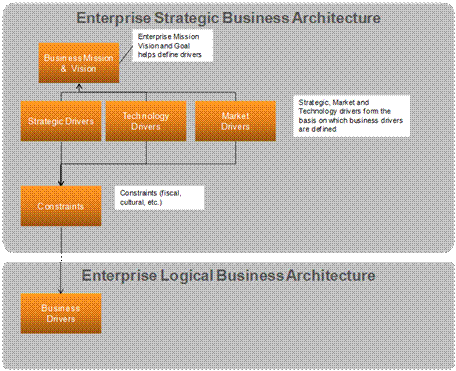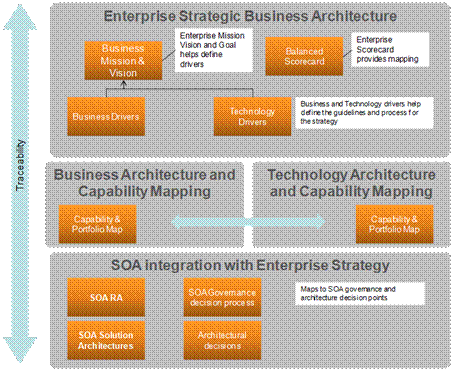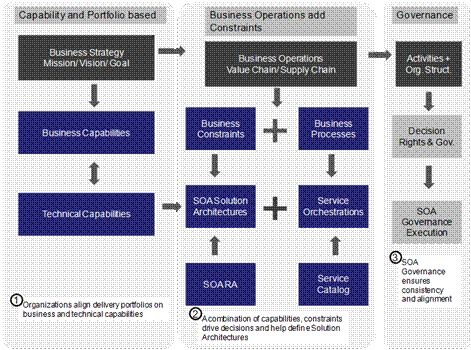SOA for Business Technology – Definitions and Motivation
Service-Oriented Architecture (SOA)
Introduction
Businesses face a fundamental need in today’s landscape to be agile, foster and enable innovation, and improve quality at a lower cost. A service-oriented model, where business success is defined in terms of metrics aligning enterprise mission, vision, and goals, to enterprise business capabilities and business processes, enabled by services fundamentally facilitates this, by taking away the “how” from the “what”. This enables organizations to focus on business value and not the underlying implementation, allowing them to be better, faster, and cheaper. SOA provides the framework around which this service enablement is supported. It also positions organizations to integrate and leverage cloud resources, which are inherently service-based.
In a world that is in the process of changing perspectives towards sustainable value creation, it seems only logical to focus on values added. This also goes for enterprises and supportive IT landscapes, where this concept unfolds as being focused on contribution to end products and services delivered in each and every process step.
Service-orientation is a way of creating autonomous building blocks of added value that in themselves are so independent from other building blocks that they can be optimized on whatever criteria, knowing that the contribution to the end product is safeguarded.
In that sense it is a strong means for separation of concerns especially in complex environments.
In this section we will elaborate on the main characteristics and the mechanism behind SOAs.
Business Drivers for Service-Orientation
What does it mean to be service-oriented? Putting it like this, every business representative nowadays would be able to produce a list of arguments and related benefits. Used in the context of IT, mentioning service-orientation can make IT people smile but often makes business representatives uncomfortable. Although effective in some parts of IT development and deployment, it never proved to be the big enabler or cost saver that it was told or expected to be. This makes it fundamentally necessary to be able to articulate service value in terms of business value and success. It is also important to make sure that service-orientation is understood in terms of organizational goals, which include, for example, agility and not cost alone.
Having said so, we do see a drive to focus on customers’ needs and organize business in a way that is aligned with the dynamics in those needs. At the same time organizations try to improve the effectiveness and efficiency of their business processes by focusing on the added value of each process step. This means a change in focus from “what” and “how” to “why”. This implies a change from internally focused to externally focused. Focused on why you do business, and who you serve, not how you implement it technically.
Some of the most common business drivers are:
- Provide agility for business to re-align business capabilities to meet ever-changing market drivers, in a quick and cost-effective manner
- Ability to meet constantly changing compliance and regulatory requirements
- Position organization to reap benefits from internal, external, and/or cloud-based services, whichever may be optimal
- Provide measurable cost and value metrics to help in timely and efficient procurement of external services
- Provide a clear and usable governance model to support and manage both internal and externally provided services
Service-orientation is a way of thinking that is closely related to value chain thinking. In that sense it is a way of thinking that should be easy to adopt in organizations focusing on effectiveness and efficiency.
It supports separation of concerns by using a disjunctive yet complete and consistent representation of a system based on autonomous components called services. It can be applied in (separate) parts and different levels of architecture. However, it should never be used without the notion and application of other viewpoints in order to be effective, the most important viewpoint being the orchestration viewpoint (process approach).
Business Technology
Introduction
Where the lifecycle of IT has brought us from directly taking over manual actions within the business processes, via centralized facilities finally governed as a separate business unit, we are now at the point where enterprises will have to reintegrate IT facilities and make them a key differentiator in doing business. Essentially, this new Business Technology view requires IT to include focus on business outcomes at all times while requiring business to include IT as an integral part of decision-making in implementing business capabilities. This approach pushes organizations towards a closer business-IT integration.
Although this is not fully recognized yet by current enterprise CxO levels, the newer CxO generations are growing up with direct access to and interaction with IT facilities and hence will start demanding more control over the IT facilities.
Industry Definition
Forrester defines Business Technology (BT) as:
“A slow but relentless revolution in which traditional technology management, historically delivered only by an IT organization, is changing to be pervasive technology use managed increasingly outside of IT’s direct control and measured by boosting business results.”
Business Drivers behind SOA4BT
The past years have shown that an autonomous IT department managed separately from the commercial and operational departments of an organization very rarely meet the expectations of the management. IT departments put great effort into trying to meet these expectations leading to new methods, techniques, and organizational models. Despite all progress made in general, IT departments still fall short in meeting the expectations of the organization and are seen as a cost center giving a main focus on costs to cut.
Business departments, while making business decisions, have in turn primarily focused on achieving immediate business value and involved costs with no consideration for long-term flexibility and constraints, which is compounded by lack of inclusion of IT.
Some organizations are starting to recognize this and include IT in decision-making rather than telling IT departments what to do within the constraints of a fixed amount of business assets allocated to these IT departments. They start making decisions based on the possibilities and constraints related to the facilitating IT. This also leads to more realistic expectations that can be met. One way or the other it means that business development and IT development should be aligned and (also within an architectural approach) should be looked at jointly.
IT cannot be structured and developed separate from the business and the business cannot be structured and developed separate from the IT.
Most senior executive (CxO-level) stakeholders distil this into metrics that align with mission, vision, and goal (strategy). Business cases based on cost-benefit analysis focus on specific, line of business, or business problem-related issues.
To summarize, Business Technology is not a new technology for doing business nor is it a business-related focus in technology. It is a more holistic way of business thinking including all IT-related aspects.
SOA4BT Taxonomy
Introduction
Where we see service-orientation as a valuable leading principle in current and future architectural approaches on the one hand, and a reintegration of IT facilitators in the day-to-day business on the other, it may be obvious that we feel a need to interconnect both phenomena.
In that perspective we recognized, or rather defined, the concept of SOA4BT, which focuses on applying the steering concept of SOA to guide the new challenges that enterprises are facing.
We will define a consistent set of concepts for SOA4BT and explain relationships between those concepts.
Defining Business Drivers
To understand the role of SOA4BT, we need to realize that technology plays an ever-increasing strategic and tactical role in organizational agility, cost efficiency, and quality. However, technology remains the enabler for business capabilities. A Service-Oriented Enterprise (SOE) over time becomes structured to operate based on services rather than organizational units. This is a fundamental difference in the way the business operates, shifting from a collection of silos, to a capability-based organization. Thus SOA enables an organization to become an SOE. This alignment of business and technology enabled by SOA is what makes SOA so important – it creates pervasive change, both in technology and in the way the enterprise is run.
We define business drivers as “processes, conditions, or events that influence and determine continued organizational success”.
Categorizing Business Drivers
Drivers impacting organizations can be categorized into three groups – strategic, market, and technical.
Strategic drivers are drivers that determine long-term organizational direction. In order to achieve the alignment provided by SOA, organizations need to understand their strategic drivers. Strategic drivers may be derived, for example, from Porter’s five forces analysis (refer to: http://en.wikipedia.org/wiki/Porter_five_forces_analysis) models and business operating models, to help determine long-term organizational direction.
Market drivers can be defined as trends that cause markets to develop and grow. They change market contexts and constrain organizational strategy. They may be slow-changing or disruptive in nature. For example, the emergence of renewable energy as a potentially feasible alternative to traditional options is changing the way in which utilities work. Another example is the Affordable Health Care for America Act (refer to: http://en.wikipedia.org/wiki/Affordable_Health_Care_for_America_Act), which has changed the business environment and models of numerous healthcare organizations.
Another factor that impacts an organizations business success is technical drivers. Technical drivers are drivers influenced by IT change. They can change the business environment – either directly or indirectly. For example, the advent of e-business has driven out of business organizations such as Borders as technology made their business models obsolete.
Thus strategic, market, and technology drivers help define the environment in which businesses operate and compete. In particular, they define the business drivers on which an SOE aligns itself.
This defines an organizational model for business – a strategic Business Architecture model. The following figure illustrates this model.

Strategic Business Architecture Model
Business Drivers Typically Most Impacted by Service-Orientation
A common set of cross-industry drivers most impacted by service-orientation adoption are:
- Speed and TTM: Leveraging common services (whether internal or external) and business processes forms the basis for an SOA. Common services in turn help reduce redundant activity, improving speed and TTM.
- Agility: Service-orientation enables agility. It provides a framework of reuse (the shared capabilities of services) and a framework to orchestrate and compose services in order to service consumers. It also provides support for governance and cross-domain consumption. These fundamental attributes enable agility, enabling organizations to quickly respond to changing business drivers.
- Cost: As services mature and both the underlying infrastructure and the services themselves are reused, costs are reduced. It should be noted that cost should normally not be a fundamental driver in SOA adoption, but understood as a corollary to the process of creating an SOE.
The Role of Business Drivers in an SOE
Traceability from organizational drivers through service-orientation starts with organizational alignment on mission, vision, and goals. Organizational vision is aspirational, defining what an organization aspires to become or believes in. The organizational mission lays out tangible direction and how it will be achieved. The mission gets decomposed into specific goals – things that are tangible and realizable. Finally we further decompose this into objectives that are measurable – which is where KPIs come into scope. This forms a quantifiable basis for aligning business strategy with architectural realization. Boards do not understand services created or components reused. However, they do understand improved customer service numbers, or improved TTM or cost.
Thus understanding the business drivers, their impact on organizational vision, mission, and goal, and the metrics that can be used to measure them is very important for an organization adopting service-orientation through the enterprise.
In particular, businesses face a growing need to be agile and act both strategically and tactically on business drivers. In order to do so they need to view IT as an enabler rather than an organization or unit providing a supporting shared service. To achieve this, businesses need to define strategic plans that are focused and aligned on business drivers. Predictive models used to forecast and align strategic vision should use these drivers and associate them with actionable metrics. Service-orientation provides the framework to support this approach – translating into agility, cost reduction, improved TTM, and quality.
A Taxonomy for Business Drivers
Business drivers may be classified using the taxonomy provided below into the following kinds of driver:
- Regulatory
- Disruptive (either due to technology or business reasons)
- Innovation (leading to disruptive drivers)
- Complementary capabilities achieved through partnerships (typically establishing market drivers)
- Substitute products (the threat of substitute products forces changes in business models)
- Established rivals (established rivals drive competition, threatening margins and value)
- New entrants
- Supplier bargaining power
- Customer bargaining power
These business drivers can be translated into drivers of IT strategy. In particular, SOA provides a measurable model to align and enable these business drivers.
The following figure shows this model and how enterprise strategy translates into SOA implementation. This model provides a basis for alignment and traceability.

Business Driver Alignment Model
As the figure shows, the ability to align business drivers, metrics, and actual implementation in an agile manner is one of SOA’s differentiators.
SOA for Business Technology
The following figure shows how SOA4BT works, how business aligns technology implementation in an SOE.
